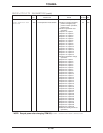
TOSHIBA
9 - 3
Parameter Explanations
GROUP: FUNDAMENTAL PARAMETERS #1 and GROUP: FUNDAMENTAL PARAMETERS #2 allow the
user to store unique V/Hz, accel/decel, etc. parameters for two motors to be operated on one drive at
different times.
Item 1, MAXIMUM OUTPUT FREQUENCY - This parameter cannot be changed while the motor is running,
and affects accel/decel times, binary frequency references, and many other parameters and functions. To
limit the drive's ouput frequency range, adjust UPPER LIMIT FREQUENCY and/or LOWER LIMIT
FREQUENCY (see Items 6 and 7 below).
Item 2, BASE FREQUENCY #1 - This parameter sets the frequency at which the drive's output voltage
reaches its maximum.
Item 3, BASE FREQUENCY VOLTAGE SELECTION - The parameter affects the drive's maximum output
voltage as follows:
0: The output voltage fluctuates with the input voltage.
1: The output voltage is set according to the input voltage when the drive is first powered.
2: The output voltage is set by Item 4, MAXIMUM OUTPUT VOLTAGE #1.
Item 4, MAXIMUM OUTPUT VOLTAGE #1 - This parameter sets the drive's maximum output voltage. The
output voltage cannot exceed the input voltage.
Item 5, REVERSE DISABLE OPERATION SELECTION - The drive will not run in reverse with this
parameter set to '1'.
Item 6, UPPER LIMIT FREQUENCY - This parameter sets the maximum frequency the drive will output,
regardless of reference.
Item 7, LOWER LIMIT FREQUENCY - This parameter sets the lowest speed the drive can run, regard-
less of reference. If this parameter is set to a non-zero value and the drive is given a run command (i.e.
F-CC closure or RUN button), the drive will run at LOWER LIMIT FREQUENCY if the reference is less
than LOWER LIMIT FREQUENCY.
Item 8, VOLTS PER HERTZ PATTERN - This parameter cannot be changed while the motor is running.
The value here sets the way the output voltage changes with output frequency:
1: Constant torque: Drive varies its output voltage linearly with its output hertz change (at 30 Hz,
output voltage is approximately half of what it is at 60 Hz).
2: Variable torque: Drive varies its output voltage as the square of its output hertz change (at 30
Hz, ouput voltage is approximately 1/4 of what it is was at 60 Hz).
3: Automatic torque boost: Drive increases its output voltage at low output Hz to increase motor
starting torque.
4: Automatic torque boost with energy saving feature: Same as number 3 above, but drive lowers
output voltage during lightly-loaded periods (reduces idle amps).
5: True torque control: Drive maximizes torque developed by motor and compensates for
motor slip. Item 298, BLIND FUNCTION SELECTION and Item 315, MOTOR PARAMETERS
BLIND, must also be set to "1" so that GROUP:MOTOR PARAMETERS can be adjusted (see
page 8-31).
6: True torque control with energy saving feature: Same as number 5 above, but drive lowers
output voltage during lightly-loaded periods (reduces idle amps).


















